For the first time I've managed to get consistently good knurls with a cheap non-adjustable knurler I heard many people say "it's useless". So I decided to share my method in the beginner forum for others to use.
First few photos of the parts I recently knurled with the tool:
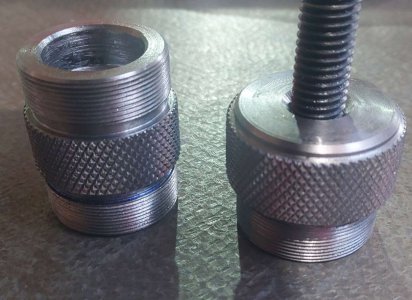
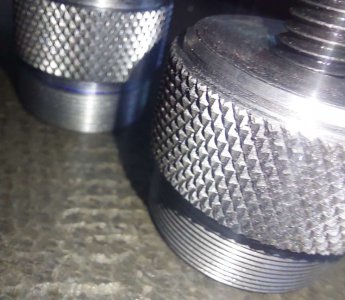
This was done with a tool like this one:
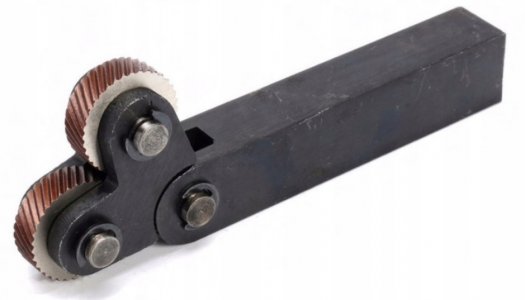
In a setup like this:
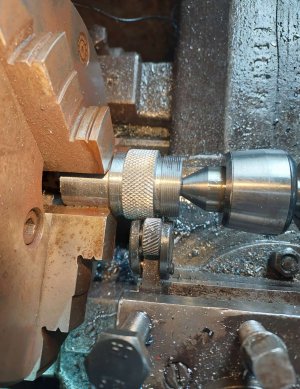
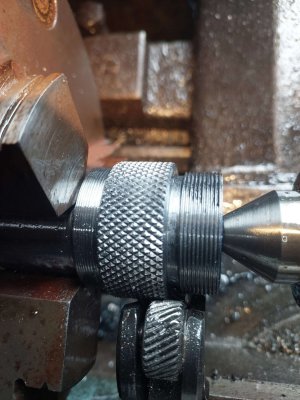
The process is surprisingly easy, but it requires a test before you knurls your target part. Here are the steps:
First you need to come up with the starting diameter for the part. This step is very important and the only complex bit. If you mess it up you'll still get a functional knurls, but it's not going to look like even diamonds...
So:
- choose some desired starting stock diameter
- go to this website (knurling calculator): https://www.cgtk.co.uk/metalwork/calculators/knurl insert the pitch of your knurling rolls (usually 1.5mm in cheap ones). Put in your stock diameter and see what number the "how much to remove" field shows. Decrease the stock diameter number by a small amount 0.1mm (4 thou) for example and observe how the "how much to remove" number changes. It will get smaller and smaller until it suddenly jumps up. The goal is to find a stock diameter, smaller than the stock you have that results in the biggest amount to remove number.
Let's do an example (in metric, but the calculator works in inches too).
My stock is 37mm, my knurls is 1.5mm. I enter those in and I see 0.24mm to remove. I then put in 36.9 in stock diameter and the amount to remove drops to 0.12. I keep lowering the number until 36.7 I notice the amount to remove suddenly jumps to 0.41mm. I could use this as my stock diameter, or I can try adding a little 0.05mm for example to 36.75mm to see if the number increases and it does to 0.46mm to remove. If I increase more it will drop again. This is the best diameter to start knurling for my stock. Remember this value this is how deep we'll knurls. Double that if your lathe's dial shows diameters.
- So I turn down my 37mm part to 36.75mm (it is better to be less, not more).
- I cut chamfers on both sides of the area to knurls (technically only one is necessary, but two look good)
- I set my lathe's auto feed to 0.2mm/rev (8 thou/rev) and my rpm to 180 rpm (you want it slow, but not so slow you fall asleep while doing it - 10m/min or 30sfpm is good I found).
- I find where my knurling tool touches the work, I zero my lathe dial on this.
- I position my knurling tool just barely getting onto the chamfer (40 thou or so, 1mm).
- I start the lathe. Pour some oil on the work, rapeseed or sunflower oils work well. My lathe shows diameters so I'm supposed to go 2*0.46=0.92mm. I'll push the knurls in until I feel quite a bit of pressure (0.4mm or so - all while rotating). Then engage the feed. Pour oil on it all the time and let the k url traverse the entire part, but don't let it get off it. When it gets where it overhangs the chamfer by half the roll stop the feed, reverse it (keep chuck rotation direction the same) and feed the other way.
- repeat few times, then stop at the starting point, see if you can dial in more depth now (there should be less pressure). If so, dial in a reasonable amount (0.4mm maybe - 10 thou).
Once you get to your target depth, your knurls will not be done... This is because this is a high pressure operation. Work and your lathe will flex. This is where testing comes in... I know I need to dial in about 0.4mm extra. If you dial in too much no worries, you just stop knurling sooner (just don't apply too much pressure, the lathe should flex a little, but not where it sounds unhealthy). If you apply to little you're not going to get a fully formed knurl so you can apply more then. Keep going until you're happy with the knurl.
That's it.
There are few tips:
-Use lots of good oil. What is good oil? Believe it or not, but edible plant oils are very good for this. That's what I use. Bo doubt mineral cutting oils could be used too
- support your work with the centre
- knurl near the chuck
- have some feel for how much pressure is ok, don't break your lathe on the first try...
When it first starts knurling it looks like one roll is good, but the other one is making a wrong pattern. Don't worry about it, the knurl starts to look good about 2/3rds way in.
You may do the above if you're cheap and like buying cheap tools, or you can buy/build a scissor or a screw machine knurler and forget about what diameter to start on, how much to dial it in etc. Watch tubalcain video on knurling if you want to see those... But good luck finding them in reasonable price.
Edit: Sorry for consistently calling a knurl "knurls", my silly autocorrect is at fault. When I have some time later I'll edit this post.
First few photos of the parts I recently knurled with the tool:


This was done with a tool like this one:

In a setup like this:


The process is surprisingly easy, but it requires a test before you knurls your target part. Here are the steps:
First you need to come up with the starting diameter for the part. This step is very important and the only complex bit. If you mess it up you'll still get a functional knurls, but it's not going to look like even diamonds...
So:
- choose some desired starting stock diameter
- go to this website (knurling calculator): https://www.cgtk.co.uk/metalwork/calculators/knurl insert the pitch of your knurling rolls (usually 1.5mm in cheap ones). Put in your stock diameter and see what number the "how much to remove" field shows. Decrease the stock diameter number by a small amount 0.1mm (4 thou) for example and observe how the "how much to remove" number changes. It will get smaller and smaller until it suddenly jumps up. The goal is to find a stock diameter, smaller than the stock you have that results in the biggest amount to remove number.
Let's do an example (in metric, but the calculator works in inches too).
My stock is 37mm, my knurls is 1.5mm. I enter those in and I see 0.24mm to remove. I then put in 36.9 in stock diameter and the amount to remove drops to 0.12. I keep lowering the number until 36.7 I notice the amount to remove suddenly jumps to 0.41mm. I could use this as my stock diameter, or I can try adding a little 0.05mm for example to 36.75mm to see if the number increases and it does to 0.46mm to remove. If I increase more it will drop again. This is the best diameter to start knurling for my stock. Remember this value this is how deep we'll knurls. Double that if your lathe's dial shows diameters.
- So I turn down my 37mm part to 36.75mm (it is better to be less, not more).
- I cut chamfers on both sides of the area to knurls (technically only one is necessary, but two look good)
- I set my lathe's auto feed to 0.2mm/rev (8 thou/rev) and my rpm to 180 rpm (you want it slow, but not so slow you fall asleep while doing it - 10m/min or 30sfpm is good I found).
- I find where my knurling tool touches the work, I zero my lathe dial on this.
- I position my knurling tool just barely getting onto the chamfer (40 thou or so, 1mm).
- I start the lathe. Pour some oil on the work, rapeseed or sunflower oils work well. My lathe shows diameters so I'm supposed to go 2*0.46=0.92mm. I'll push the knurls in until I feel quite a bit of pressure (0.4mm or so - all while rotating). Then engage the feed. Pour oil on it all the time and let the k url traverse the entire part, but don't let it get off it. When it gets where it overhangs the chamfer by half the roll stop the feed, reverse it (keep chuck rotation direction the same) and feed the other way.
- repeat few times, then stop at the starting point, see if you can dial in more depth now (there should be less pressure). If so, dial in a reasonable amount (0.4mm maybe - 10 thou).
Once you get to your target depth, your knurls will not be done... This is because this is a high pressure operation. Work and your lathe will flex. This is where testing comes in... I know I need to dial in about 0.4mm extra. If you dial in too much no worries, you just stop knurling sooner (just don't apply too much pressure, the lathe should flex a little, but not where it sounds unhealthy). If you apply to little you're not going to get a fully formed knurl so you can apply more then. Keep going until you're happy with the knurl.
That's it.
There are few tips:
-Use lots of good oil. What is good oil? Believe it or not, but edible plant oils are very good for this. That's what I use. Bo doubt mineral cutting oils could be used too
- support your work with the centre
- knurl near the chuck
- have some feel for how much pressure is ok, don't break your lathe on the first try...
When it first starts knurling it looks like one roll is good, but the other one is making a wrong pattern. Don't worry about it, the knurl starts to look good about 2/3rds way in.
You may do the above if you're cheap and like buying cheap tools, or you can buy/build a scissor or a screw machine knurler and forget about what diameter to start on, how much to dial it in etc. Watch tubalcain video on knurling if you want to see those... But good luck finding them in reasonable price.
Edit: Sorry for consistently calling a knurl "knurls", my silly autocorrect is at fault. When I have some time later I'll edit this post.



